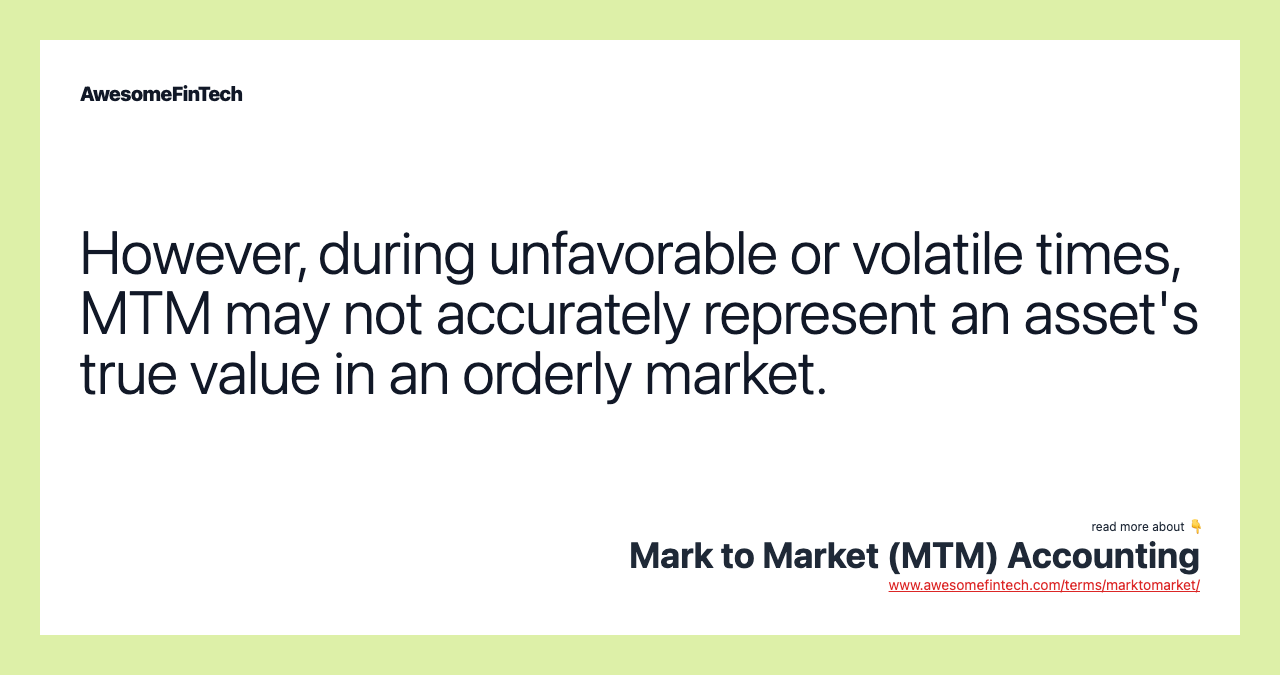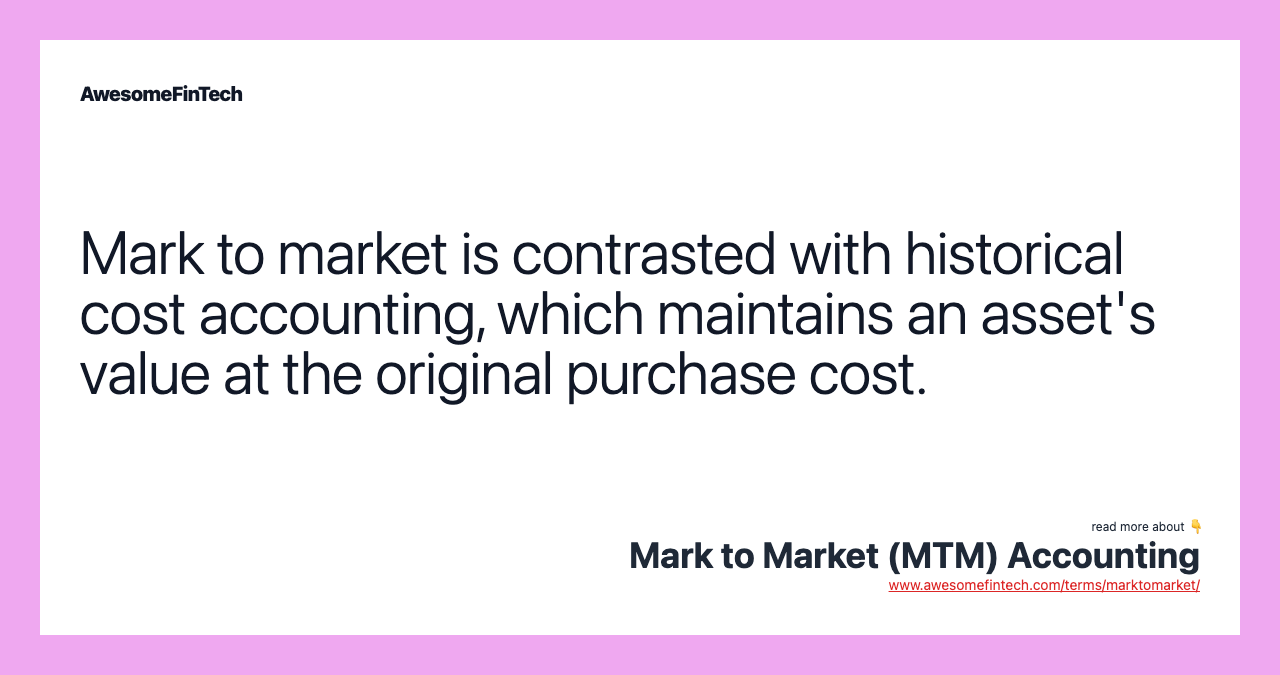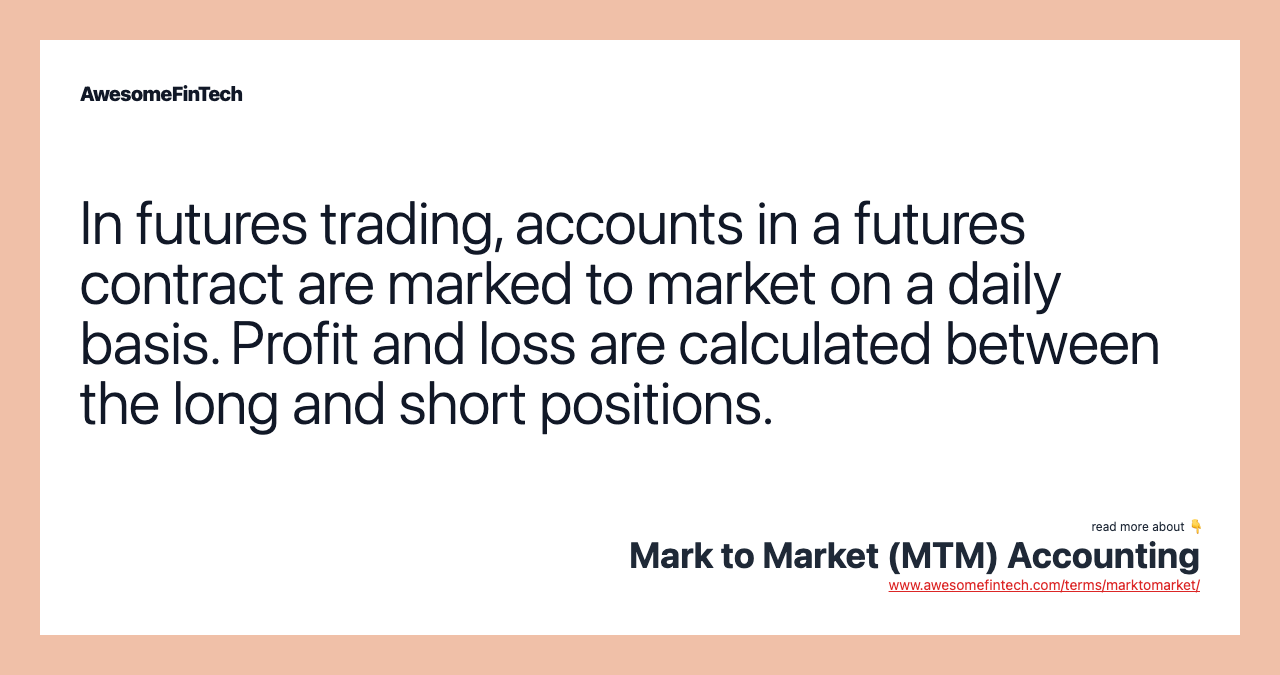Mark to Market (MTM) Accounting
Mark to market (MTM) is a method of measuring the fair value of accounts that can fluctuate over time, such as assets and liabilities. In securities trading, mark to market involves recording the price or value of a security, portfolio, or account to reflect the current market value rather than book value. Historical cost measures the value of the original cost of an asset, whereas mark to market measures the current market value of the asset. Mark to market can present a more accurate figure for the current value of a company's assets, based on what the company might receive in exchange for the asset under current market conditions. 1:41 Mark to market is an accounting practice that involves adjusting the value of an asset to reflect its value as determined by current market conditions.

What Is Mark to Market (MTM)?
Mark to market (MTM) is a method of measuring the fair value of accounts that can fluctuate over time, such as assets and liabilities. Mark to market aims to provide a realistic appraisal of an institution's or company's current financial situation based on current market conditions.
In trading and investing, certain securities, such as futures and mutual funds, are also marked to market to show the current market value of these investments.




Understanding Mark to Market
Mark to Market in Accounting
Mark to market is an accounting practice that involves adjusting the value of an asset to reflect its value as determined by current market conditions. The market value is determined based on what a company would get for the asset if it was sold at that point in time. At the end of the fiscal year, a company's balance sheet must reflect the current market value of certain accounts. Other accounts will maintain their historical cost, which is the original purchase price of an asset.
For example, companies in the financial services industry may need to make adjustments to their asset accounts in the event that some borrowers default on their loans during the year. When these loans have been identified as bad debt, the lending company will need to mark down its assets to the fair value through the use of a contra asset account such as the "allowance for bad debts."
A company that offers discounts to its customers in order to collect quickly on its accounts receivables (AR) will have to mark its AR to a lower value through the use of a contra asset account. In this situation, the company would record a debit to accounts receivable and a credit to sales revenue for the full sales price. Then, using an estimate of the percentage of customers expected to take the discount, the company would record a debit to sales discount, a contra revenue account, and a credit to "allowance for sales discount," a contra asset account.
In personal accounting, the market value is the same as the replacement cost of an asset. For example, homeowner's insurance will list a replacement cost for the value of your home if there were ever a need to rebuild your home from scratch. This often differs from the price you originally paid for your home, which is its historical cost to you.
Mark to Market in Investing
In securities trading, mark to market involves recording the price or value of a security, portfolio, or account to reflect the current market value rather than book value. This is done most often in futures accounts to ensure that margin requirements are being met. If the current market value causes the margin account to fall below its required level, the trader will be faced with a margin call. Mutual funds are also marked to market on a daily basis at the market close so that investors have a better idea of the fund's Net Asset Value (NAV).
Examples of Mark to Market
An exchange marks traders' accounts to their market values daily by settling the gains and losses that result due to changes in the value of the security. There are two counterparties on either side of a futures contract - a long trader and a short trader. The trader who holds the long position in the futures contract is usually bullish, while the trader shorting the contract is considered bearish.
If at the end of the day, the futures contract entered into goes down in value, the long margin account will be decreased and the short margin account increased to reflect the change in value of the derivative. Conversely, an increase in value results in a increase to the margin account holding the long position and a decrease to the short futures account.
For example, to hedge against falling commodity prices, a wheat farmer takes a short position in 10 wheat futures contracts on November 21, 2019. Since each contract represents 5,000 bushels, the farmer is hedging against a price decline on 50,000 bushels of wheat. If the price of one contract is $4.50 on November 21, 2019, the wheat farmer's account will be recorded as $4.50 x 50,000 bushels = $225,000.
Futures Price
Change in Value
Gain/Loss
Cumulative Gain/Loss
Account Balance
Note that the Account Balance is marked daily using the Gain/Loss column. The Cumulative Gain/Loss column shows the net change in the account since day 1.
Because the farmer has a short position in wheat futures, a fall in the value of the contract will result in an increase to their account. Likewise, an increase in value will result in a decrease in account value. For example, on Day 2, wheat futures increased by $4.55 - $4.50 = $0.05, resulting in a loss for the day of $0.05 x 50,000 bushels = $2,500. While this amount is subtracted from the farmer's account balance, the exact amount will be added to the account of the trader on the other end of the transaction holding a long position on wheat futures.
The daily mark to market settlements will continue until the expiration date of the futures contract or until the farmer closes out his position by going long on a contract with the same maturity.
Special Considerations and Recent History of Mark to Market
Problems can arise when the market-based measurement does not accurately reflect the underlying asset's true value. This can occur when a company is forced to calculate the selling price of its assets or liabilities during unfavorable or volatile times, as during a financial crisis. For example, if the asset has low liquidity or investors are fearful, the current selling price of a bank's assets could be much lower than the actual value.
This issue was seen during the financial crisis of 2008/09 when the mortgage-backed securities (MBS) held as assets on banks' balance sheets could not be valued efficiently as the markets for these securities had disappeared. In April of 2009, however, the Financial Accounting Standards Board (FASB) voted on and approved new guidelines that would allow for the valuation to be based on a price that would be received in an orderly market rather than a forced liquidation, starting in the first quarter of 2009.
How does One Mark Assets to Market?
Mark to market is an accounting standard governed by the Financial Accounting Standards Board (FASB), which establishes the accounting and financial reporting guidelines for corporations and nonprofit organizations in the United States. FASB Statement of Interest "SFAS 157–Fair Value Measurements" provides a definition of "fair value" and how to measure it in accordance with generally accepted accounting principles (GAAP). Assets must then be valued for accounting purposes at that fair value and updated on a regular basis.
Are All Assets Marked to Market?
While marking to market is the industry standard, some assets simply do not have a good market price available for use. Assets that must be instead marked-to-model either don't have a regular market that provides accurate pricing, or have valuations that rely on a complex set of reference variables and timeframes. This creates a situation in which guesswork and assumptions must be used to assign value to an asset, which makes the asset riskier.
Historical cost accounting is another alternative method used to record the price or value of an asset. Historical cost measures the value of the original cost of an asset, whereas mark to market measures the current market value of the asset. The historical cost method is often used for sunk costs or fixed expenses. Depreciation is always calculated based on historical cost whereas impairments are always calculated on mark to market. Physical assets are more often recorded at historical cost whereas marketable securities are recorded at mark to market.
What Are Mark to Market Losses?
Mark-to-market losses are paper losses generated through an accounting entry rather than the actual sale of a security. Mark-to-market losses occur when financial instruments held are valued at the current market value, which is lower than the price paid to acquire them.
Related terms:
Accounting
Accounting is the process of recording, summarizing, analyzing, and reporting financial transactions of a business to oversight agencies, regulators, and the IRS. read more
Accounts Receivable (AR) & Example
Accounts receivable is the balance of money due to a firm for goods or services delivered or used but not yet paid for by customers. read more
Bad Debt
Bad debt is an expense that a business incurs once the repayment of credit previously extended to a customer is estimated to be uncollectible. read more
Balance Sheet : Formula & Examples
A balance sheet is a financial statement that reports a company's assets, liabilities and shareholder equity at a specific point in time. read more
Bear
A bear is one who thinks that market prices will soon decline, or has general market pessimism. read more
Book Value : Formula & Calculation
An asset's book value is equal to its carrying value on the balance sheet, and companies calculate it by netting the asset against its accumulated depreciation. read more
Bull
A bull is an investor who invests in a security expecting the price will rise. Discover what bullish investors look for in stocks and other assets. read more
Current Market Value (CMV)
The current market value is the present value of a financial instrument, which can be the closing price or the bid price depending on the item. read more
Commodity Futures Contract
A commodity futures contract is an agreement to buy or sell a commodity at a set price and time in the future. Read how to invest in commodity futures. read more
Contra Account
A contra account is an account used in a general ledger to reduce the value of a related account. A contra account's natural balance is the opposite of the associated account. read more